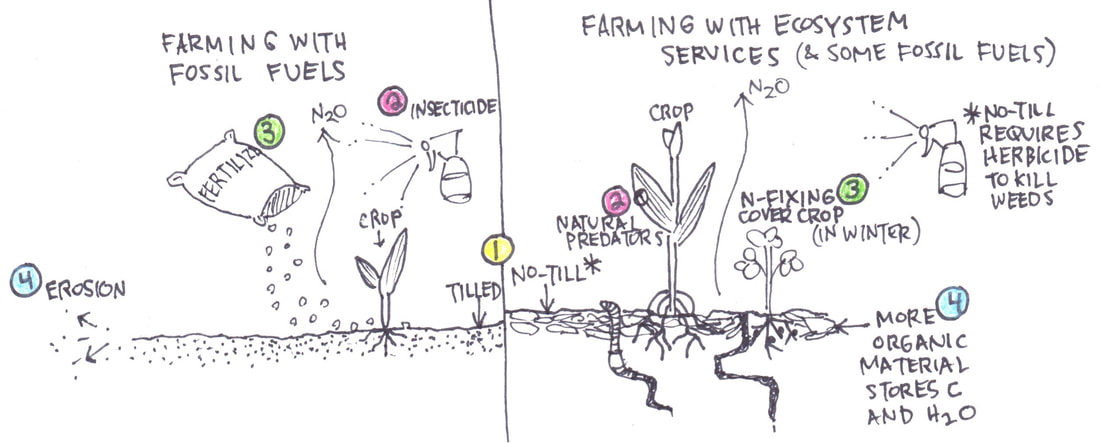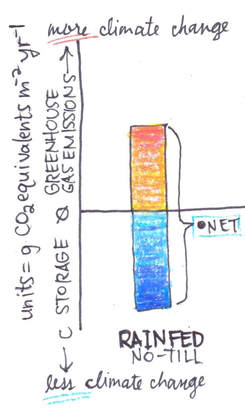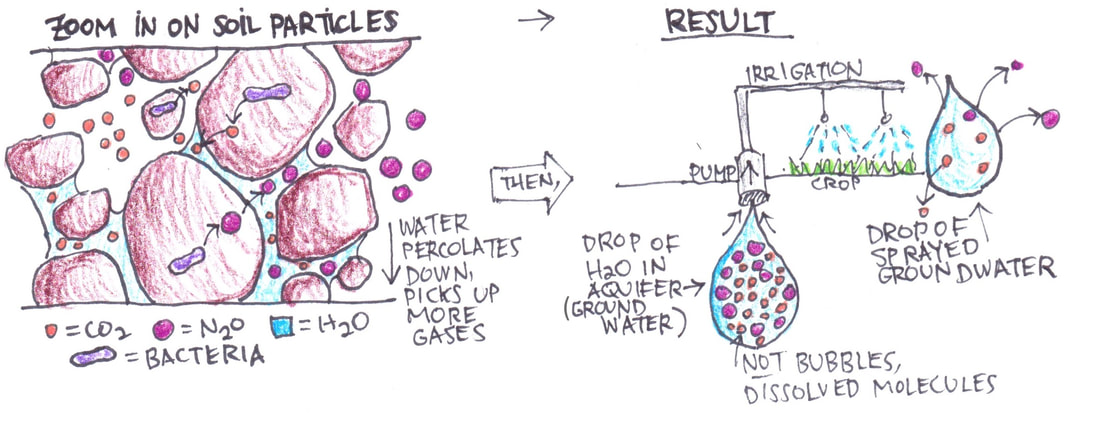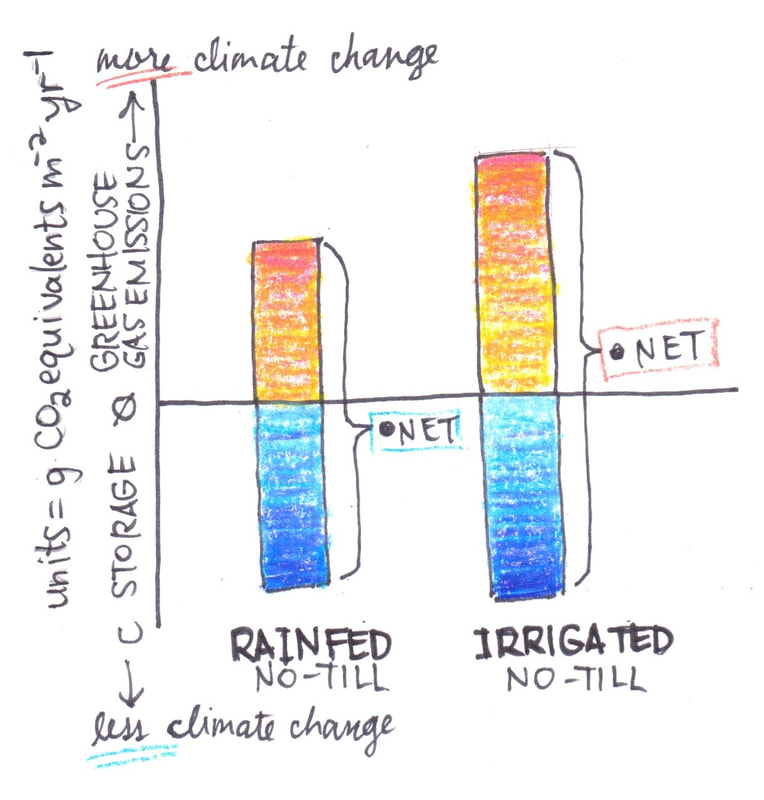|
This blog post is written to explain the results from my research at the KBS LTER to middle and high school students I’m working with through the Skype a Scientist program. Any scientist or teacher can sign up to participate. Update 25 Oct. 2018: You can now read the open access journal article on this work in Global Change Biology. Who are you and what do you do? I’m an ecosystem ecologist. An ecosystem is a living community and its non-living physical environment such as its rocks, water, and air. I study how the living and non-living parts of an ecosystem interact, which determines the ecosystem’s functions or services like cleaning water, producing food, and decomposing dead things. I am particularly interested in agricultural ecosystems like corn and soybean fields, how farmers manage that land, and what effects those choices have on ecosystem functions like adding to or preventing air and water pollution. Scientists at the KBS LTER have shown that we can produce just as much (or more) food using fewer man-made materials, which involve burning fossil fuels, and using more ecosystem services like nitrogen-fixing cover crops (Figure 1). Relying more on ecosystem services reduces farm costs, such as buying insecticides, and reduces the amount of pollution from farms to the air and water. Ecosystem services can also make the farm more resilient to climate variability. Some of that air pollution can be in the form of greenhouse gases like carbon dioxide (CO2), nitrous oxide (N2O), and methane (CH4), which retain more heat in the atmosphere, warming the earth. Did you know that greenhouse gas emissions from agriculture make up about 10% of the total man-made emissions in the US? Figure 1. Farming with fossil fuels (left) or ecosystem services (right).(1) Tilling the soil breaks down soil structure making it more vulnerable to erosion by wind and water (4, left). Not tilling the soil (no-till) builds up soil structure, protects the soil from erosion, and allows the soil to store more organic material (carbon) and water (4, right). To kill weeds no-till requires synthetic herbicides, which are made, transported, and applied using fossil fuels (2, left). Conventional farming uses insecticides to control crop pests, while farming with ecosystem services promotes biodiversity in the landscape such that natural predators of crop pests (ladybugs, birds, etc.) control crop pests. This means leaving a patch of forest rather than turning it into a crop field and/or planting patches of wildflowers at the edges of fields. (3, left) Man-made nitrogen fertilizer requires a lot of fossil fuels to produce, while a nitrogen-fixing cover crop (3, right) can provide nitrogen to the soil without as much fossil fuels. At the KBS LTER, I wanted to measure the carbon footprint of irrigation—spraying water on crops. By carbon footprint, I mean how irrigation impacts a farm’s contribution to or prevention of climate change. In other words, does an irrigated corn field contribute more or less greenhouse gases to the atmosphere than a rainfed (non-irrigated) field? What did you find?
You see, as water percolates through the soil and through the aquifer (Figure 3, left), microbial processes like respiration and denitrification are occurring, but their gas products can’t escape. Instead gases like CO2and N2O build up to really high concentrations in the water in dissolved form. Then, when that water is exposed to the atmosphere (Figure 3, right) the gases equilibrate with the atmospheric concentration of those gases, much like when you open a new bottle of pop—CHHHH! The CO2 escapes from the pop. So groundwater-irrigated farming has this additional source of greenhouse gases on top of regular greenhouse gas emissions from rainfed farming. This surprised me because other studies like this one did not measure this source. Figure 3. We discovered greenhouse gas emissions from groundwater-fed irrigation. Previous studies of the carbon footprint of irrigation did not measure the greenhouse gas content of the irrigation water itself. We measured the concentration of CO2, N2O, and CH4 in groundwater before it was sprayed on the field (lower water drop) and calculated how much gas was lost when the water equilibrated with the atmosphere (upper water drop). Also, irrigation requires more fossil fuels than rainfed crops in order to pump the water from belowground. At the KBS LTER, about 75% of our electricity comes from fossil fuels (60% of the total comes from coal). (Where does your electricity come from?) Besides these additional sources, irrigation also increased the amount of N2O emissions from the soil (also found in rainfed soils but at lower rates) by encouraging denitrification, a process carried out by soil bacteria.
CO2-equivalents per kg crop yield (AKA greenhouse gas intensity), both the rainfed and irrigated systems are very close to zero net impacts at KBS. So rainfed doesn't look quite as rosy and irrigation doesn't look as bad. The downside is that intensification with irrigation puts more demand on aquifers and rivers to provide the irrigation water. The majority of the world's aquifers supporting the most important agricultural areas are already overexploited.
These results are specific to KBS, and could very well differ by climate, tillage (we did not compare tilled vs. no-tilled), and soil type. We don’t have many studies like this, in fact this is the first one for the US Midwest. Why is your work exciting? Irrigation, thought of as a way for farmers to adapt to climate change, might actually be contributing to climate change. All the more reason for improving irrigation efficiency to minimize impacts on water resources and reduce contributions to climate change. In the big picture, this work excites me because it has implications for real world issues. I like being a part of the LTER community of scientists trying to figure out how human activities contribute to climate change, how we can modify those activities to reduce or reverse their contribution to climate change, and what is the best way to work with farmers to help them meet their yield goals and (not or) conservation goals.
Tim Gannon
4/11/2018 05:43:49 am
Outstanding work Bonster! You communicate very well. Comments are closed.
|
Archives
February 2019
Categories |




 RSS Feed
RSS Feed
